Tuesday Jan 20, 2026
Tuesday Jan 20, 2026
Monday, 23 November 2020 01:47 - - {{hitsCtrl.values.hits}}
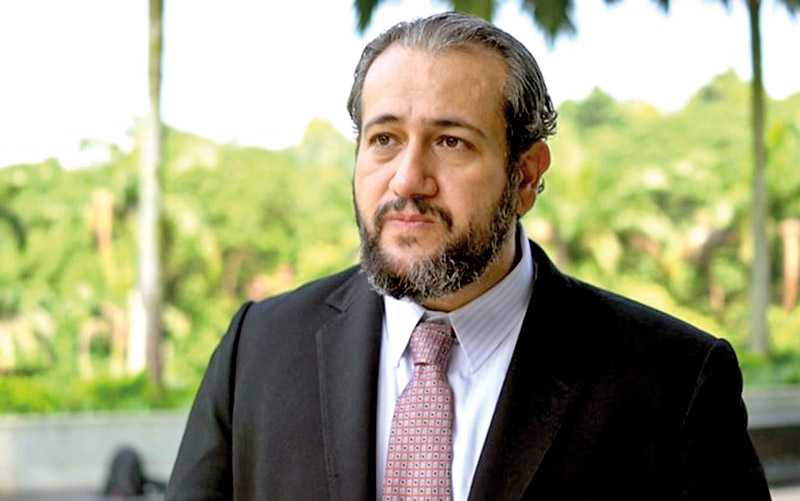
World Bank’s new Country Director for Sri Lanka, Maldives and Nepal Faris Hadad-Zervos
World Bank’s new Country Director for Sri Lanka, Maldives and Nepal Faris Hadad-Zervos remains confident of Sri Lanka overcoming its socio-economic challenges, taking strength from considerable strides thus far and the resilience amidst global and locals shocks including the COVID-19 pandemic. According to him, the future can ensure more sustainable and inclusive growth provided Sri Lanka pursues credible reforms and consistent policy, as well as social impact and climate friendly measures.
The World Bank currently has an ongoing assistance portfolio of $ 2.36 billion and under its new medium term program, talks on which are to start next year, will align with Government priorities and adapt to emerging development needs. Here are excerpts:
By Nisthar Cassim
Q: What is your initial assessment on Sri Lanka’s socio-economic development in recent years?
My initial assessment is that Sri Lanka has made considerable strides in its socioeconomic development over the years, and that there remains vast potential for the future under the right circumstances.
Sri Lanka has made significant progress in the recent past. Since the end of the conflict in 2009, the economy grew at an average 5.3% during the period 2010-2019, with a tapering off in the years leading up to the COVID-19 crisis. The economy has been transitioning from a predominantly rural-based economy to a more urbanised economy oriented around services and manufacturing.
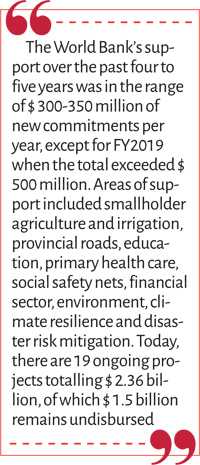 |
 |
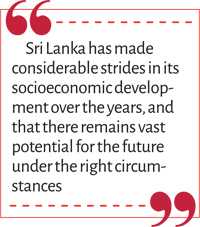 |
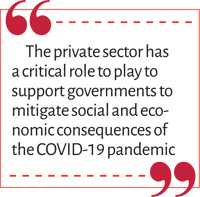 |
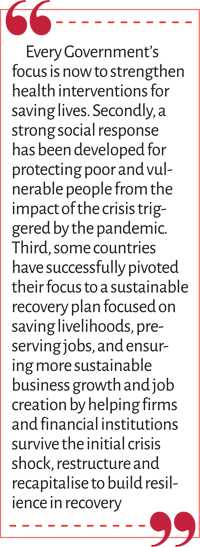 |
 |
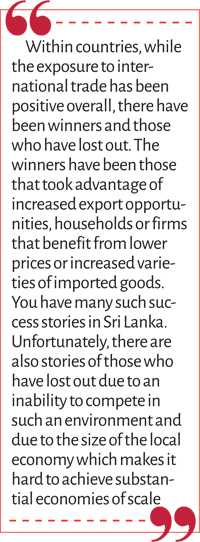 |
Social indicators rank among the highest in South Asia and compare favourably with those in other middle-income countries. Sri Lanka has historically excelled in human capital outcomes, with high literacy rates and good outcomes in maternal and child health.
Using the international poverty rate of $3.20 per person per day (in 2011 Purchasing Power Parity terms), poverty is estimated to have declined from 37.3% in 2002 to 10.8% in 2016. Projections indicate that poverty further fell to 8.9% by 2019. Extreme poverty is quite low and concentrated in some geographical pockets. Nevertheless, it is important to note that a significant subset of the population hovers above the poverty line, with a chance of falling back into poverty if any shock (such as COVID-19) happens.
Q: In your view how successfully has Sri Lanka managed the COVID-19 pandemic?
We believe the Government of Sri Lanka has made a very solid commitment to contain the spread of the virus from the outset of the pandemic. The Government has prioritised people’s health and lives that have manifested in the significantly lower number of COVID-19 cases and associated deaths compared to its neighbours.
The policy measures implemented in the early stages of the outbreak were one of the most stringent in the world as measured in the Oxford Stringency Index (marked the highest score of 100 in April). The response capacity was rapidly expanded during the pandemic including contact tracing, testing, isolation, and ICU capacity. The country’s strong leadership that followed a ‘whole-of-Government approach’ was one of the key contributory factors to this success.
In support of these efforts, the World Bank-financed Sri Lanka COVID-19 Emergency Response and Health Systems Preparedness Project is supporting the Government’s ‘test, track, isolate and treat’ strategy to control the pandemic by providing a steady supply of essential medical necessities, testing kits, and Personal Protective Equipment (PPE), supporting contact tracing efforts, and maintaining quarantine and treatment centres. It is also working to strengthen the health system to better manage health emergencies in the future.
Q: What are the short-, medium- and long-term socio-economic challenges for Sri Lanka?
In the short-term, Sri Lanka like all other countries is facing the need to strike a balance between controlling COVID-19 while triggering an economic recovery and a return to a better and more resilient growth storyline. This is no easy task. The pandemic has triggered sharp economic contraction and led to jobs and earnings losses. A longer downturn could push many small and medium enterprises from illiquidity to insolvency, and the poverty rate could rise.
Low growth would also put additional strain on public finances and the financial sector. Asset quality and earnings of the financial businesses have indicated some deterioration, reflecting the impact of decelerating loan recoveries and shrinking margins. A high deficit and rising debt levels could deteriorate debt dynamics and pose risks to fiscal sustainability.
Across the world, countries are grappling with important structural challenges over the medium to long-term in a post-COVID world. Some are even taking advantage of the crisis to identify opportunities to pivot their long-term strategies towards a green growth agenda with strong focus on climate resilience.
We are also seeing many countries grapple with limitations in fiscal space due to the economic downturn that is limiting many governments’ ability to drive growth, create jobs and facilitate economic transformation. Therefore, the issue then becomes about how to turn this around by, say, diversifying and optimising all sources of income and rationalising spending. Diversification of exports is one important priority, including expanding of products, destinations and Sri Lankan content in the supply chain of the exports.
Furthermore, this is the perfect time to address the twin virtues of competitiveness and a welcoming investment climate. Both feed off of each other and in turn drive a country’s recovery by bringing in investments, knowhow and a healthy playing field for firms to compete and to ‘up their game’. Ironically but not surprisingly, this global crisis presents a perfect time to address these issues. All of this is not new to the Government, as this is embedded in the current plans and priorities.
Q: The new Government presented the 2021 Budget. Your initial assessment?
It is clear that the COVID-19 crisis has created a convergence of approaches across different countries. One commonality across country budgets is the effort balance between spending for COVID-19-related expenses and basic services and ensuring macro-fiscal sustainability over the long-term. The trade-offs are not easy, of course.
Governments are also seeking innovative ways to maintain revenues without burdening COVID-affected households and businesses too much. Re-prioritising and rationalising public investments is a natural decision at this time, but it will be critical to still identify key investment priorities to maintain stimulus and momentum on long-term growth. After all, maintaining investments in key sectors remains important, even in this global environment.
One clear way to keep this momentum under the likely current budget constraints is to leverage private and foreign investment to fill in the gaps where possible. As such, countries are now turning to the investment climate, and to the ecosystem for innovation and for skills development. In the post-COVID-19 world competitiveness for FDI and private investment will be the name of the game.
Q: In recent years globally and regionally we have seen a shift to inward looking and protectionist policies? What is the World Bank’s take on this as well as free trade?
There is indeed a very interesting debate on the benefits of trade. It is important to approach this debate thoughtfully, looking at all arguments and points of view. We all know that globalisation has largely been good for development and trade has been crucial to poverty reduction. The expansion of international trade has boosted demand for labour-intensive products from developing countries. This has helped lift large numbers of people out of poverty in just a few decades.
Trade has been especially important for small developing countries, in which trade provided a way for increasing productivity through increased scale of production and through technology transfers, ultimately leading to the creation of more and better jobs. I don’t think anyone disagrees with that point of view, which is historically verifiable.
Of course, within countries, while the exposure to international trade has been positive overall, there have been winners and those who have lost out. The winners have been those that took advantage of increased export opportunities, households or firms that benefit from lower prices or increased varieties of imported goods. You have many such success stories in Sri Lanka.
Unfortunately, there are also stories of those who have lost out due to an inability to compete in such an environment and due to the size of the local economy which makes it hard to achieve substantial economies of scale. There is no doubt that this creates hardships and vulnerabilities for people, whose voices must be heard.
What I would say here is that there is a middle way, a common ground. Here, the existence of strong safety nets and other social protection policies becomes critical. Also, there are ways to enhance workers’ skills and support firm capabilities to make Sri Lankan firms globally competitive. Thirdly, there is huge potential in Sri Lanka through identifying niche tradeable products (e.g., Ayurveda, high-end packaged products) and niche services (tourism) that allows for greater competitiveness, and therefore prosperity and jobs.
Q: What kind of policies or reforms will be needed for Sri Lanka to recover from the COVID pandemic and achieve economic growth to become an upper middle-income country?
Rather than to try and prescribe to the Government what needs to be done – which is not for the World Bank to do – allow me to share what appears to be a common approach across the majority of countries.
Obviously, we are in the middle of an unprecedented global crisis. The priority for all countries during this period has been to weather the crisis with limited harm, and to lay a strong foundation to build back better. First, every government’s focus is now to strengthen health interventions for saving lives. Secondly, a strong social response has been developed for protecting poor and vulnerable people from the impact of the crisis triggered by the pandemic. Third, some countries have successfully pivoted their focus to a sustainable recovery plan focused on saving livelihoods, preserving jobs, and ensuring more sustainable business growth and job creation by helping firms and financial institutions survive the initial crisis shock, restructure and recapitalise to build resilience in recovery.
Q: What role should the private sector play especially in the context of challenges arising out of COVID-19 pandemic?
The private sector has a critical role to play to support governments to mitigate social and economic consequences of the COVID-19 pandemic. Right now many businesses globally have been forced to suspend or limit operations due to mandatory travel restrictions, imposed social distancing and home-based working requirements, resulting in reduced firm outputs. Larger firms can often rely upon public support and use its own savings, additional financing and debt restructuring, and resort to costs optimisation to drift through the challenging times.
On the other hand, most SMEs, especially the smaller ones, do not even have access to formal finance while their own savings and capital buffers are often too thin to cover even basic costs in the absence of a steady cash flow. This is where the governments and central banks have stepped in to support the most vulnerable market segments in economies to address their immediate liquidity challenges. These have been very welcome moves.
Larger firms also have an important role to play in terms of protecting their workers and other stakeholders in the short-term to ensure the wellbeing of the workforce, service providers and clients; repurpose business capabilities to meet immediate needs of the economy, protecting jobs of employees through guaranteed income and minimise layoffs; and support their supply chains. Once the outbreak has subsided these efforts will contribute to build a more resilient private sector and a better prepared response mechanism to face any future crisis. We’re all in it together.
Q: What sectors would you identify as Sri Lanka’s future growth drivers?
It is not for the World Bank to predict which sectors or industries will become future growth drivers. However, what we clearly know is that Sri Lanka has significant untapped resources and assets, both human and natural.
As a relatively small but strategically located country, Sri Lanka can tap a massive potential from trade and private investment including FDI to fuel growth. We see potential in many areas including – but not limited to – tourism, information technology, logistics, renewable energy, manufacturing, agriculture and agro-businesses.
Other countries that have unleashed the growth potential in these sectors have done so by putting in place the necessary conditions for a thriving knowledge economy, by investing in sophisticated tourism offerings, by helping integrate productive local companies in global value chains, by promoting digital development and by attaining higher value addition in the manufacturing and service sectors through innovation and standards.
Q: Can you briefly share how the World Bank has increased its support and engagement with Sri Lanka in recent years and what can people expect going forward during your tenure? What are World Bank priorities for the next four to five years?
The World Bank’s support over the past four to five years was in the range of $ 300-350 million of new commitments per year, except for FY2019 when the total exceeded $ 500 million. Areas of support included smallholder agriculture and irrigation, provincial roads, education, primary health care, social safety nets, financial sector, environment, climate resilience and disaster risk mitigation. Today, there are 19 ongoing projects totalling $ 2.36 billion, of which $ 1.5 billion remains undisbursed.
At the start of the COVID-19 pandemic, the World Bank responded swiftly and leveraged the existing portfolio as much as possible by reallocating resources. We moved quickly in April 2020 to support the Government of Sri Lanka through the COVID-19 Health Emergency Response and Health Systems Preparedness Project of $ 128.6 million. Mostly using funds repurposed from other existing projects, the project was topped up in June with an additional $ 88.96 million (including a $ 1.72 million grant), largely to support cash transfers to the most vulnerable people (elderly, disabled, chronic kidney patients). In addition, we had a Social Safety Net project in the portfolio which was restructured so that $ 45 million could be disbursed in early May 2020.
We are currently discussing with the Government ways to adjust the existing portfolio further to better align with Government priorities and adapt to emerging development needs. For the medium-term, we will start consultations next year for our new Country Partnership Framework (CPF), which will define directions and priority areas of our engagements in Sri Lanka over the next four to five years. Specific areas will be determined based on the Government’s request and in line with the country’s priorities, other development partners’ support and the World Bank’s comparative advantage.